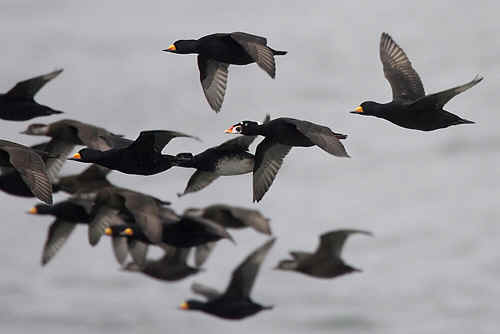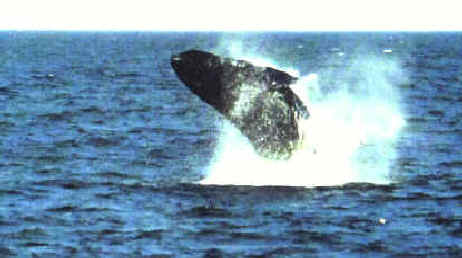
E-mail: font@focusonnature.com
Phone: Toll-free in USA 1-888-721-3255
or 302/529-1876
 |
PO
Box 9021, Wilmington, DE 19809, USA E-mail: font@focusonnature.com Phone: Toll-free in USA 1-888-721-3255 or 302/529-1876 |
The
FOCUS ON NATURE Tour
in
WASHINGTON STATE & CALIFORNIA
September 2005
OUR WEST COAST USA BIRDING & NATURE TOUR
"Following
the Path of Lewis & Clark,
and Crossing Paths with a Bird from Hawaii"

Scoters fly over the ocean at
Cape Disappointment,
the westernmost point of the Lewis & Clark Expedition,
and our westernmost point during the FONT 2005 West Coast Tour.
Links:
Lists of
Birds, with some photos, of: Washington
State California
Mammals & Other Wildlife during FONT West Coast USA Tours (with
some photos)
Upcoming FONT West Coast USA Birding & Nature Tours
The following narrative of the FONT Sep '05 West Coast USA Tour was
written by Armas Hill, leader of the tour:
During the second week of September
in 2005, we did our 13th West Coast USA Birding & Nature Tour, that included portions of Washington
State & California. As usual, the first part of this tour of just
over a week was in Washington State, while the second part was in California.
One of the days during the California
portion of the tour, September 17, '05, was
for us a very good day at sea, during a pelagic trip, that lasted a good part of
that day, out of Monterey.
A true rarity was seen, an Hawaiian Petrel. It's rare for North American
waters, rare for California (only a couple times or so), and a rare bird
overall. In Hawaii, the only place where this threatened species breeds, the
total population is estimated at 4 to 5 thousand pairs. The population of this
bird on Hawaii was formerly considered as part of the Galapagos Petrel. But,
differences in molecular data, vocalizations, and morphology have shown the
Hawaiian Petrel to be a distinct species.
Other pelagic species during the Sept 17 Monterey pelagic trip, that was part of the '05 FONT West Coast Tour, included Black-footed Albatross, Northern Fulmar, Short-tailed Shearwater, Sooty Shearwater, Pink-footed Shearwater, Buller's Shearwater, and 3 species of Storm-Petrels: Ashy, Black, and Least. Also seen were 3 species of alcids: Common Murre, Pigeon Guillemot, and Rhinoceros Auklet, as well as both Parasitic and Pomarine Jaegers, and South Polar Skua.
Also, during the pelagic trip, there were some tremendous looks at
Marine Mammals. Among them, there was a group of 8 Baird's Beaked Whales, with 4 of them floating on the surface of the water close to the boat.
Baird's Beaked Whale
And there were also Humpback
Whales,
with 8 of them with their breaching out of the water, including such activity by
a mother with her calf (apparently learning how to do it).
Again, as noted, it was a very good day for us at sea.

Humpback Whale
Other aspects of the tour were certainly good too. In all, in both Washington
and California, we saw 186 species of birds, and a nice assortment of mammals.
In Washington State, we traveled in the
southwest portion of the state, and then east over the Cascades, before
returning west to the Seattle airport.
Just about two hundred years earlier, in late 1805, another group traveled into
what's now Washington State.
The Lewis & Clark Expedition, after coming west from the Mississippi, went
(as we did) into the southwest portion of Washington State, along the Columbia
River to the Pacific, to Cape Disappointment,
before returning east back over the Cascades. (No, they didn't make their
way, as we did, back to the Seattle Airport.)
But it was recorded that they saw a California Condor during that part of
their journey, along the Columbia before the Pacific. We, of course, could not
enjoy such a sighting, but Cape Disappointment was not a disappointment for us.
From the lighthouse there, atop a bluff overlooking the Pacific, we looked out
on the ocean and saw: Pacific Loons, Western Grebes, Sooty Shearwaters,
Pelagic Cormorants, all 3 species of scoters, Parasitic Jaeger,
Black-legged Kittiwake, and an assortment of other gulls, and terns.
In all, there were lots of birds, and, no, Cape Disappointment was not that for
us at all.
On the bluff where we above the ocean, in the trees there were Chestnut-backed
Chickadees, Red-breasted Nuthatches, and Purple Finches keeping us
company. Flickers and Robins were migrating south along the coast,
as they would that time of year.
Shortly after our tour, in our money back at home, there began to appear a new
version of the 5-cent coin, a nickel with the image of the lighthouse at Cape
Disappointment, where we were, depicting the trees where there were, with us, chickadees,
above the ocean where we saw the shearwaters and other birds. That
nickel, of course, commemorated the arrival of Lewis & Clark at their
westernmost point by the Pacific. It was a nice experience for us to be there
200 years later. (And to remember each time we'd see that new nickel.)
North of Cape Disappointment, along the Washington Coast, the previous day of
our tour was another good one. We drove that day along the beach for a few
miles, and there were many shorebirds for us to see.
Among them, we had some nice encounters with Snowy Plovers (a rather
rare bird in Washington State), and there were a few Pacific Golden
Plovers near a large number of Black-bellied Plovers.
Of all the shorebirds, it was the Sanderling that was in the largest
numbers.
Other shorebird species included: Red Knot, Willet, Whimbrel, Marbled Godwit,
Black Turnstone, Western Sandpiper, and both dowitchers.
Inland in Washington, there were, for us, more nice encounters with birds.
Early one morning, in a magnificent old evergreen forest we shared an untraveled
road with only Varied Thrushes. We saw well a dozen or more of them
there, on the road just outside our vehicle.
One afternoon, in an isolated grove of deciduous trees, mostly aspen, near the
Columbia River, there were many warblers. Most of them were Black-throated
Grays (we saw more than any of us ever saw at any one place in our
lives), but there were also Orange-crowned and Yellow Warblers,
and for us a single Hermit Warbler. All of these, of course, had picked
that particular grove of trees as a resting spot during their southward
migration.
East of the Cascades in
Washington, we visited another spot that birds chose as a resting and feeding
place on their way south. It was a small, shallow pond surrounded by a mudflat.
There we saw Pipits of one kind and Sparrows of various sorts, and
shorebirds that included: Pectoral, Baird's, Least, and White-rumped
Sandpipers. The last of these is an uncommon migrant in Washington State.
As we were watching these and other birds in the area, we were distracted that
afternoon by the numerous California Quails, in groups, running about and
calling. With the calls of the quails, the place had the sound rather like an
old Western movie.
Then it was on to California, for the second half of the tour, and to one of our
favorite locales there, the Point Reyes National
Seashore, along the Pacific Coast, north of San Francisco. It is
truly one of the most picturesque places in North America, or anywhere. And it
is one best anywhere for birds. About 425 species of birds, overall, have been
recorded there. Large numbers can be present, and particularly in September (as
when we were there), with all the groups well-represented: waterbirds,
landbirds, shorebirds, seabirds, and raptors.
We saw many of each.
Notable for us were the raptors, with large numbers of Red-tailed
Hawks, some with interesting "western plumages", in the terrain of
open fields on the peninsula, where also there were harriers and numerous
kestrels, in addition of other species such as Golden Eagle and Red-shouldered
Hawk.
Entertaining for us at Point Reyes were the many Red-necked Phalaropes spinning
about on virtually every shallow pool of water.
Other migrants included Flycatchers on their way south, mostly Willow,
but also Pacific Slope, and Swainson's Thrushes, that resting by
the side of the road early in the morning after a long flight from the south.
American White Pelicans were seen, during the day, flying in, also to
rest, on the water of the channel above the San Andreas Fault.
"Western" birds, of course, migrate through Point Reyes in September
in numbers, but actually, every year, "Eastern" birds are to be
expected there as well. We saw on a wire an Eastern Kingbird (by the
way, we saw no Westerns), and at one feedlot we saw both Black-headed
and Rose-breasted Grosbeaks feeding together. Most Eastern Kingbirds
and Rose-breasted Grosbeaks are many, many miles to the east of coastal
California.
On our way to Point Reyes, instead of avoiding the city of San
Francisco, we traveled through it, and we made some stops before
crossing the Golden Gate Bridge.
Out over the bay, by Alcatraz, we saw
strings of Brown Pelicans in flight. "Alcatraz", of course, is
a word that means "pelican".
In the city, atop Telegraph Hill, we stopped
to view the flocks of Red-masked Parakeets (from South America) that
have become established there, and when doing so, had a good look or two at an Anna's
Hummingbird. The parakeets there are, needless to say,
"exotic", and the whole San Francisco experience was rather so as well
for those of us from the eastern US.
Another place we visited in California during the tour was also quite
"different" for us. It was the town of Gilroy,
known as the "Garlic Capital of the World". And you knew it when you
were there.
It was, however, for us a rather fine place (especially when the windows were
closed). Just east of Gilroy, we had some fine birding in the San
Joaquin Valley.
We go there, for about a day, during all of our September West Coast Tours. We
went to an area this time where, during another tour, we had seen thousands, yes
thousands, of Long-billed Curlews and White-faced Ibis feeding
together on an alfalfa field. We saw no such thing this time. Conditions each
year are different, due to weather or for whatever reason. But we did, in
September '05, find a wetland, where among other birds we found American
Bitterns and Sora, two species that are always nice to find. While
birding there, we flushed more than a half-dozen bitterns.
Also there, we saw a single Sandhill Crane (apparently one that
stayed) in an area where thousands would be during the winter.
And the other bird we always like to see in San Joaquin Valley, we saw - the Yellow-billed
Magpie. It's a species that's endemic to California. The Tricolored
Blackbirds that we saw there are nearly so.
Our West Coast USA birding in September '05 could have continued, of course,
beyond the 10 days of the tour. There would have been more to see. But it had to
end when our time was up. We could only look forward to doing it again, another
time!